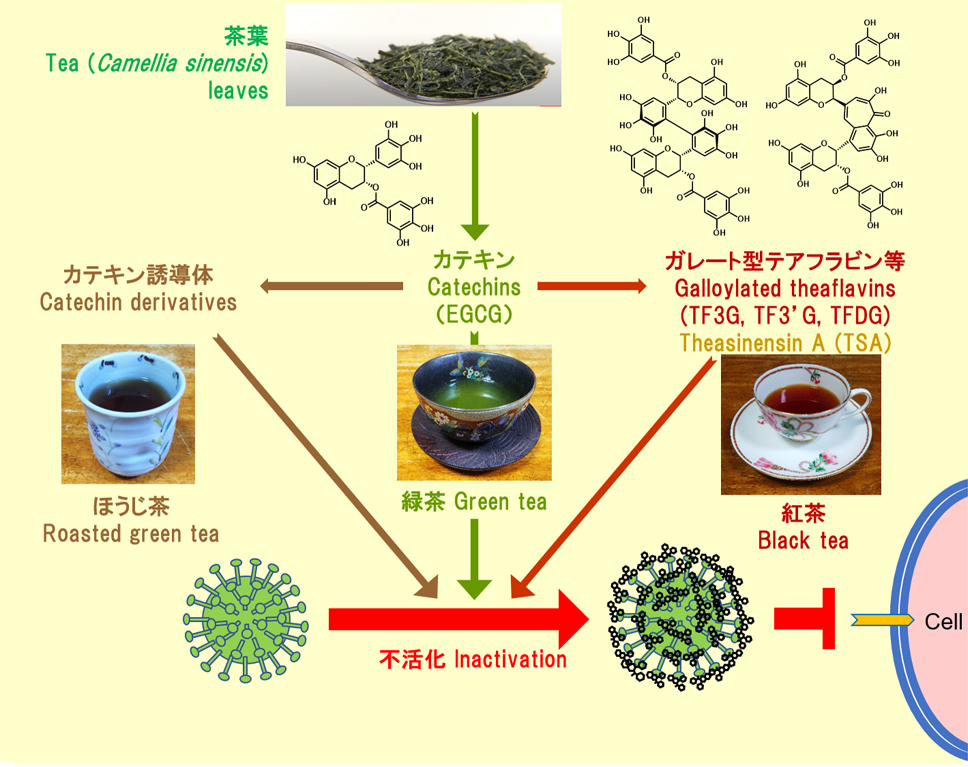プロジェクトのご紹介 3 - Project 3 -
緑茶カテキン、カテキン誘導体、およびガレート型テアフラビンによる新型コロナウイルスの試験管内での有意な不活化;紅茶と緑茶による試験管内での唾液中の新型コロナウイルスの迅速な不活化
Significant Inactivation of SARS-CoV-2 by a Green Tea Catechin, a Catechin-derivative and Galloylated Theaflavins in vitro; Rapid Inactivation in vitro of SARS-CoV-2 in Saliva by Black Tea and Green Tea

Potential effects of tea and its constituents on SARS-CoV-2 infection were assessed in vitro. Infectivity of SARS-CoV-2 was decreased to 1/100 to undetectable levels after a treatment with black tea, green tea, roasted green tea, or oolong tea for 1 min. An addition of (−) epigallocatechin gallate (EGCG) significantly inactivated SARS-CoV-2, while the same concentration of theasinensin A (TSA) and galloylated theaflavins including theaflavin 3,3′-di-O-gallate (TFDG) had more remarkable anti-viral activities. EGCG, TSA, and TFDG at 1 mM, 40 µM, and 60 µM, respectively, which are comparable to the concentrations of these compounds in tea beverages, significantly reduced infectivity of the virus, viral RNA replication in cells, and secondary virus production from the cells. EGCG, TSA, and TFDG significantly inhibited interaction between recombinant ACE2 and RBD of S protein. These results suggest potential usefulness of tea in prevention of person-to-person transmission of the novel coronavirus.
Saliva plays major roles in the human-to-human transmission of SARS-CoV-2. We assessed whether tea inactivated the SARS-CoV-2 which was added in human saliva. A virus was added in healthy human saliva in vitro, and after treatment with black tea or green tea, the infectivity of the virus was evaluated by TCID50 assays. The virus titer fell below the detectable level or less than 1/100 after treatment with black tea or green tea for 10 s. The black tea-treated virus less remarkably replicated in cells compared with the untreated virus. These findings suggest the possibility that the ingestion of tea may inactivate SARS-CoV-2 in saliva in infected individuals, although clinical studies are required to determine the intensity and duration of the anti-viral effect of tea in saliva in humans.
茶とその構成成分のSARS-CoV-2感染への効果を試験管内で検証した。紅茶、緑茶、ほうじ茶、ウーロン茶のいずれかで1分間処理すると、SARS-CoV-2の感染力は100分の1あるいは検出感度以下にまで低下した。エピガロカテキンガレート(EGCG)はSARS-CoV-2を有意に不活化した一方、テアシネンシンA(TSA)とテアフラビン-3,3’-O-ガレートを含むガレート型テアフラビンはさらに顕著な抗ウイルス活性を示した。飲用の茶に含まれている濃度に近い、1 mMのEGCG、40 µMのTSA、60 µMのTFDGをそれぞれ加えると、ウイルスの感染力、細胞内でのウイルスの複製、細胞から2次的なウイルスの産生がいずれも有意に低下した。EGCG、TSA、TFDGは組換えACE2とSたんぱくのRBDの間の相互作用を有意に抑制した。これらの結果は、新型コロナウイルスがヒト-ヒト間で伝播するのを抑制する上で、茶に潜在的な有用性があることを示唆している。
一方、SARS-CoV-2の飛沫感染には、唾液中のウイルスが主要な役割を演じている。そこでヒト唾液に加えたSARS-CoV-2を茶が不活化するか否かを検討した。試験管内で、ヒト唾液にSARS-CoV-2を加え、紅茶または緑茶で10秒間処理すると、ウイルスの感染力価は検出感度以下または1/100以下に低下し、細胞から産生される2次ウイルスも著明に減少した。紅茶で処理したウイルスは非処理ウイルスに比して細胞内での増殖が低かった。これらの結果は、茶の摂取が感染者の唾液内のSARS-CoV-2を不活化する可能性を示唆している。しかしヒトの唾液内における茶の抗ウイルス効果の程度と期間を知るためには今後臨床研究が必要である。
一部プロジェクトのご紹介 - See some projects among others -
- 新型コロナウイルス・オミクロン変異株に対する茶カテキン類の効果
Effects of tea catechin-related compounds on Omicron subvariants of SARS-CoV-2 - 腫瘍微小環境の低pHはプロトンセンサーGたんぱく共役レセプターをを介して腫瘍のPDL-1の発現を低下させる
Extracellular acidity in tumor tissue upregulates programmed cell death protein 1 expression on tumor cells via proton-sensing G protein-coupled receptors - 緑茶カテキン、カテキン誘導体、およびガレート型テアフラビンによる新型コロナウイルスの試験管内での有意な不活化;紅茶と緑茶による試験管内での唾液中の新型コロナウイルスの迅速な不活化
Significant Inactivation of SARS-CoV-2 by a Green Tea Catechin, a Catechin-derivative and Galloylated Theaflavins in vitro; Rapid Inactivation in vitro of SARS-CoV-2 in Saliva by Black Tea and Green Tea - 新規多孔性3Dスキャフォールドと直接誘導骨芽細胞を用いた骨再生
Nanogel tectonic porous 3D scaffold for direct reprogramming fibroblasts into osteoblasts and bone regeneration - TGFR阻害剤による骨芽細胞のケミカル・ダイレクト・リプログラミング
Chemical direct reprogramming of human fibroblasts into osteoblasts by a TGFR blockade - 筋芽細胞のダイレクト・リプログラミングと筋管形成
Direct reprogramming of functional myoblasts that are capable of forming multinuclear myotube - シュワン細胞のダイレクト・リプログラミングと末梢神経損傷の再生
Direct reprogramming of functional Schwann cells that promote regeneration of peripheral nerve - 褐色脂肪のダイレクト・リプログラミングと代謝疾患の制御
Direct reprogramming of functional brown adipocytes that control metabolic diseases - 骨芽細胞のダイレクト・リプログラミングと骨再生
Direct reprogramming of functional osteoblasts that regenerate bone tissue - IL-21 によるアレルギー応答の制御とその分子機構
IL-21-mediated regulation of allergic responses and its molecular mechanisms - IL-27 による NK 細胞活性化と ADCC を介した腫瘍抑制
IL-27 augments NK cytotoxicity and induces ADCC-based tumor suppression - EBV- エピゾーマルベクターによる外来遺伝子の高効率導入、高発現、長期間持続の機構解明
Mechanisms underlying the high-rate transfection, high-level expression, and long-term maintenance of exogenous genes mediated by the Epstein-Barr virus-based episomal vector - 細胞の分化と初期化に伴う染色体エピジェネティック修飾の解析
Analyses of epigenetic modification of chromosomes upon cell differentiation and reprogramming

